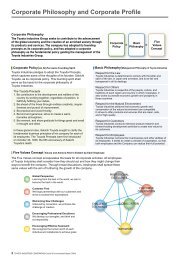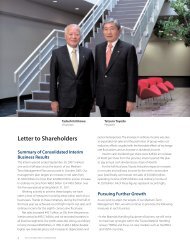Business Activities - Toyota Industries Corporation
Business Activities - Toyota Industries Corporation
Business Activities - Toyota Industries Corporation
You also want an ePaper? Increase the reach of your titles
YUMPU automatically turns print PDFs into web optimized ePapers that Google loves.
Automobile<br />
Car Electronics<br />
<strong>Business</strong> <strong>Activities</strong><br />
Automobile > Car Air-Conditioning Compressor<br />
Establishment of Car Air-Conditioning<br />
Compressor Production Base in Indonesia<br />
In January 2011, <strong>Toyota</strong> <strong>Industries</strong> established P.T. TD<br />
Automotive Compressor Indonesia (TACI), a new car<br />
air-conditioning compressor production base to<br />
respond to the growing ASEAN automobile markets.<br />
Established within the premises of P.T. DENSO<br />
Indonesia, TACI is a spin-off of DENSO Indonesia’s<br />
compressor business and took over production<br />
operations in June 2011. TACI has been supplying<br />
compressors for the Etios produced by TMC in India.<br />
TACI plans to expand its annual production<br />
capacity from the current 1 million units to 1.6 million<br />
units by fi scal 2016. By establishing a production base<br />
in Indonesia in addition to Japan, North America,<br />
Europe and China, <strong>Toyota</strong> <strong>Industries</strong> is well positioned<br />
to further augment the global supply structure and<br />
meet growing compressor demand.<br />
■Worldwide Bases of Car Air-Conditioning Compressors<br />
DNDE<br />
Germany<br />
DNTS<br />
Italy<br />
TDDK<br />
Germany<br />
DSIT<br />
Italy<br />
<strong>Toyota</strong> <strong>Industries</strong>’ car air-conditioning compressors are widely adopted by automakers<br />
around the world, garnering the No.1* position in global sales.<br />
* Survey by <strong>Toyota</strong> <strong>Industries</strong> <strong>Corporation</strong><br />
SUBROS<br />
India<br />
TACI<br />
Indonesia<br />
YSD<br />
China<br />
DICH<br />
China<br />
DNMY<br />
Malaysia<br />
Accelerating Product Development<br />
Fine-Tuned to Regional Needs<br />
<strong>Toyota</strong> <strong>Industries</strong> strives to collect information and<br />
identify needs through technical service stations for<br />
automakers established in such countries as the<br />
United States, Germany and China. Such activities<br />
allow us to precisely refl ect regionally diverse needs in<br />
product development and create products that satisfy<br />
customers.<br />
In emerging countries, <strong>Toyota</strong> <strong>Industries</strong> has<br />
developed products for compact cars, for which<br />
demand is strong, and strengthened the supply<br />
structure. In North America, Europe and Japan, we<br />
seek to enhance our environmental performance and<br />
other technological capabilities to meet the increasingly<br />
strict regulations concerning vehicle fuel effi ciency.<br />
We will also strive to establish a solid position as<br />
the leading manufacturer based on superb products in<br />
terms of performance, quality and price that<br />
outperform competitors.<br />
TICO<br />
Japan<br />
TACK<br />
China<br />
MACI<br />
U.S.A.<br />
TACG<br />
U.S.A.<br />
DNBR<br />
Brazil<br />
: Consolidated production bases<br />
: Licensed manufacturers<br />
: Technical service stations<br />
DIAM<br />
U.S.A.<br />
<strong>Business</strong> Overview in Fiscal 2011<br />
In fi scal 2011, <strong>Toyota</strong> <strong>Industries</strong> posted an increase in<br />
net sales of car electronics products due to a rise in<br />
production of HVs, including the third-generation<br />
<strong>Toyota</strong> Prius, and an increase in the number of HV<br />
models fi tted with our electronic products, such as the<br />
Lexus CT200h launched in January 2010.<br />
Assuming a Greater Role in the<br />
HV-Related Field<br />
<strong>Toyota</strong> <strong>Industries</strong> develops and produces electronic<br />
components and devices for electric-powered vehicles.<br />
We have steadily expanded the lineup and scope of<br />
vehicle installations, primarily for our auxiliary power<br />
source devices. Upon introducing the third-generation<br />
Prius, we have entered the fi eld of core components for<br />
drive systems.<br />
Auxiliary Power Source Devices<br />
A DC-DC converter converts the high voltage of HV<br />
batteries to a lower voltage level suitable for operating<br />
lights, wipers, horns and other auxiliary devices.<br />
Capitalizing on more than 10 years of experience that<br />
started with the fi rst-generation Prius, we succeeded<br />
in developing a more compact, lighter-weight converter<br />
for the third-generation Prius.<br />
As for an electric compressor integrated with<br />
an inverter, we have also developed smaller and<br />
lighter-weight models and successfully increased the<br />
number of vehicles installing our products.<br />
We developed an onboard charger optimally<br />
designed for use with high-voltage batteries by utilizing<br />
our experience in developing EV chargers in the 1990s<br />
and 1,500W AC power source devices. This onboard<br />
charger is installed in the Prius Plug-in Hybrid launched<br />
by TMC in 2009.<br />
Core Components for Drive Systems<br />
<strong>Toyota</strong> <strong>Industries</strong> applied our proprietary direct-cooling<br />
method to develop a device with signifi cantly higher<br />
cooling performance. This direct-cooling device<br />
contributed to the realization of a compact and<br />
lighter-weight power control unit (PCU) for the<br />
third-generation Prius. In January 2010, we initiated an<br />
electric power train promotion project that combines<br />
the skills and knowledge of all in-house electric motor<br />
specialists to bolster the development of core<br />
components and systems for drive systems.<br />
Model Change of Charging Stands for<br />
PHVs and EVs<br />
<strong>Toyota</strong> <strong>Industries</strong> is also involved in the development of<br />
charging infrastructure to promote greater use of PHVs<br />
and EVs. In October 2010, we launched sales of a new<br />
charging stand for PHVs and EVs jointly developed<br />
with Nitto Kogyo <strong>Corporation</strong>. This product has<br />
improved ease of use compared with existing models.<br />
It is the fi rst mass-produced charging stand in Japan<br />
to feature as a standard specifi cation communication<br />
capabilities that are essential for building a charging<br />
infrastructure network.<br />
Contributing to the<br />
Realization of a<br />
Low-Carbon Society<br />
Demand for environment-friendly<br />
automobiles with high energy<br />
effi ciency is expected to grow<br />
more rapidly, with the trend<br />
toward the electrifi cation of<br />
vehicles likely to expand.<br />
Enhancement of the charging<br />
infrastructure will also take a<br />
greater role in promoting the<br />
spread of PHVs and EVs.<br />
Targeting the high-growth,<br />
electric-powered vehicle market,<br />
we will accelerate development of<br />
technologies and products in the<br />
fi elds of auxiliary power source<br />
devices, core components and<br />
systems for drive systems and<br />
charging infrastructure, thereby<br />
making a signifi cant contribution<br />
to the realization of a low-carbon<br />
society.<br />
<strong>Business</strong> <strong>Activities</strong><br />
Automobile > Car Electronics<br />
Prius Plug-in Hybrid fi tted with <strong>Toyota</strong> <strong>Industries</strong>’ onboard charger<br />
Charging stand<br />
30 <br />
31


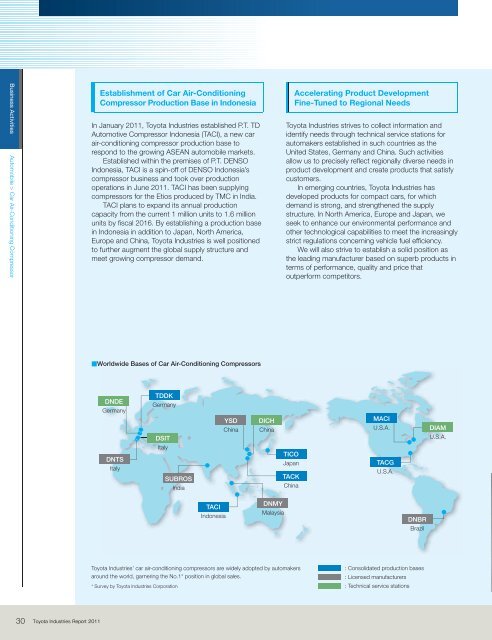
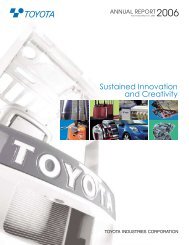
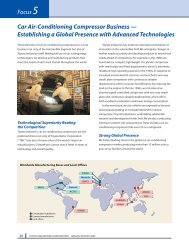
![PDF[476KB/5 pages] - Toyota Industries Corporation](https://img.yumpu.com/50288545/1/190x123/pdf476kb-5-pages-toyota-industries-corporation.jpg?quality=85)
![PDF[622KB/13pages] - Toyota Industries Corporation](https://img.yumpu.com/47399131/1/190x245/pdf622kb-13pages-toyota-industries-corporation.jpg?quality=85)
![PDF[792KB/2Pages] - Toyota Industries Corporation](https://img.yumpu.com/45510108/1/184x260/pdf792kb-2pages-toyota-industries-corporation.jpg?quality=85)
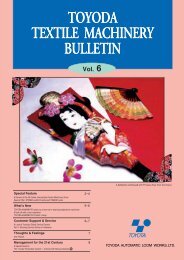


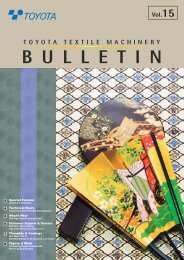
![PDF[126KB/4Pages] - Toyota Industries Corporation](https://img.yumpu.com/41525474/1/184x260/pdf126kb-4pages-toyota-industries-corporation.jpg?quality=85)
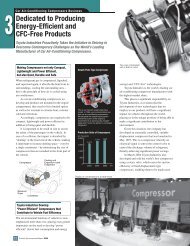
![PDF[1229KB/26 pages] - Toyota Industries Corporation](https://img.yumpu.com/40908773/1/190x247/pdf1229kb-26-pages-toyota-industries-corporation.jpg?quality=85)
